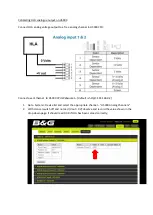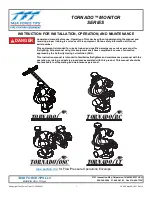
Fa
9132A Service
All input port signals
(IDO
through ID15)
can be
read
by
the Pod processor.
U98 and U46 are data buffers between
the
input ports
and the
microproces-
sor data
lines.
These ports are enabled during an input port select
(INPORTSEL-)
and
a read.
The inputs from the ROM Modules pass through a non-inverting buffer
(U45).
PROMTYPEI, 2,
and 3
are
signals
from ROM Module
1
that
determine the
type
of ROM Module.
Headers contained
on
the ROM
Module designate the size of the ROM Module
(ie.,
24-, 28-,
or 32-pin).
ROMA4SEL-,
ROM3SEL-, and ROM2SEL- are
used
for self test modes
only.
ROMISEL-,
an
output from ROM Module
1,
indicating that all of the
ROM Module
1
chip selects
and
output enables are active.
ROMISEL-
is
monitored
at
U45 to determine if
an
error exists.
ROMIPRESENT-, ROM2PRESENT-, ROM3PRESENT-, and ROM4PRE-
SENT-
on
U12 indicate how many ROM Modules are connected to the
Pod.
PM-PRESENT- indicates whether
the
Personality Module is present.
Re-
set latch (RESET-LAT)
is an
output from
the
Personality Module that
shows the module has
seen
a reset
at the
UUT microprocessor. Clack fail
(CLK-FAIL) comes from a circuit
on
page
6
of the Main Board schematics
that detects activity on
the
UUT clock
line.
Compare equal (COMPAREQ-)
is a non-clock output from
the
address comparator
(used
for self test pur-
poses here).
The DELAY ROMADDR
lines
on
Ul3
are
the
delayed versions of
the
ROM addresses. These addresses return status during certain accesses.
MAINSTAT and ABORT on U48
are
active high versions of the handshake
lines from
the
Mainframe.
Sync
fuse
sense
(SYNCFUSESENSE)
and
ROM fuse sense (ROMxFUSESENSE) indicate whether
the
fuses on the
Sync Module and ROM Modules are
good.
Pod data 0 through
7
on
U11
are
input Pod data from the Mainframe.
The ROMxPWRFAIL lines show whether power
has
failed
on
the indicated
ROM Modules.
Self test (SFTST-) indicates that a ROM Module is
plugged into the self test socket.
The self test
sync
present (STSYNC-
PRSNT-) line indicates that a
Sync
Module is plugged into the self test
socket.
BANKAAVAIL
and
BANKBAVAIL monitor the progress of the
ERAM bank
swaps.
Main
Board Address
RAM
and Sync
Module
Interface
2-8.
The Main Board Address RAM and
Sync
Module interface circuitry are
shown
on
page 6 of
the
Main Board schematic (Figure 5-1).
The address RAMs (ARAM),
U61
and U62,
are
8K
x 8
static RAMs
divided into banks of 2K
x 16.
The ARAM
is
used
as
a “mini
logic
analyzer,”
to
latch a stream of addresses from ROM Module
1
and store it
16
bits
at
a
time.
Once the address stream is latched, the Pod processor
can access the results using either byte-wide or word-wide reads.
The delayed address (DELAY ROMADDR)
can
pass through
U87
and U97
to the ARAM-DATA bus. When
the
address RAM
is
armed (by enabling
the output port bit ARAM-EN
at
U56), both
U87 and
U97 are always turned
Summary of Contents for 9132A
Page 53: ...9132A Service 9132A T B 10f 4 E 3 46 Figure 4 1 9132A Final Assembly...
Page 54: ...9132A Service DETAIL 9132A T8B 2 of 4 Figure 4 1 9132A Final Assembly cont 4 7...
Page 56: ...9132A Service MP16 POSITION 1 STRIPE 9132A T B 4 of 4 Figure 4 1 9132A Final Assembly cont 49...
Page 59: ...9132A Service Hout CEE LE RYT N Bk el FI Soho 9132A 1601 Figure 4 2 A1 Maln PCA 4 12...
Page 66: ...9132A Service 9132A 24 9132A 28 9132A 32 Figure 4 6 ROM Module Final Assembly 4 19...
Page 68: ...9132A Service 9132A 1603 Figure 4 7 AS ROM Module PCA 4 21...
















































